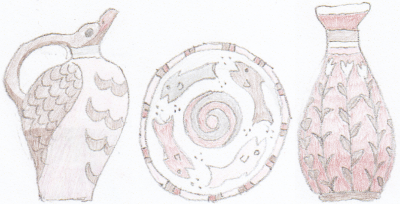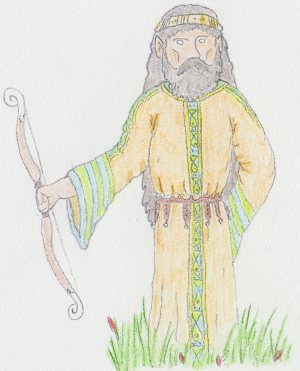Marissíans
Marissian: Marissata
Faronian: Merissol
Marissíans are elves native to Marissía in southern Adynía and form the majority of the population of the Kingdom of Marissía, with small communities found at the southern border of Zirdinóin and along the coast of Faron to the east as well. They are relatives of the Zirdinóans to the northwest, the Þataleans to the south and, more distantly, the Paheiríen-Elves of the Sjorgús Mountains to the north.
Long hair is favored by both men and women, with the former preferably sporting long beards as well.
Their writing system is based on an alphabet derived from densaral, an ancient cursive script which is also the ancestor of the faronian desa script. It lacks any kind of punctuation, instead the first letter in each word is written with red or, more rarely, blue ink.
Light linothorax-type armour, often padded, is commonly used along with more expensive scale armour among the nobility. Helmets are usually adorned with pheasant- or hoopoe feathers, while shields are usually adorned with images of dragonflies, birds or the sun.
Marissíans are elves native to Marissía in southern Adynía and form the majority of the population of the Kingdom of Marissía, with small communities found at the southern border of Zirdinóin and along the coast of Faron to the east as well. They are relatives of the Zirdinóans to the northwest, the Þataleans to the south and, more distantly, the Paheiríen-Elves of the Sjorgús Mountains to the north.
Culture
Apparel
Marissían clothing resembles that of the þataleans and the ancient larúneans, favoring tunics and robes but generally lacking trousers. Nobles prefer linen robes with wide sleeves and belts decorated with gold plaques, while commoners usually wear short-sleeved tunics or dresses made of hemp or wool. The former often wear soft leather or linen shoes, the latter usually sandals made of leather or reeds.Long hair is favored by both men and women, with the former preferably sporting long beards as well.
Art
Pottery
Traditional marissían pottery often depicts or is shaped like animals native to the region, especially around Kapor Lake, while elsewhere floral themes or mythological scenes are more common. Ducks and other waterfowl are especially popular, along with fish.Cuisine
Wheat bread, goat meat- and cheese and various vegetables are the staple food of many marissíans, with eggs, fish and fowl being commonly eaten by the rivers and the Kapor Lake. Seafood is restricted to the southeasternmost Marissía by the river Taþyrin.Language
Marissíans speak a number of languages which for a dialect continuum, with the difference most evident between the eastern and western provinces. These languages most closely related to those of the zirdinóans and þataleans, but some of their vocabulary borrows from paheiríenic, larúnean and faronian tongue as well.Their writing system is based on an alphabet derived from densaral, an ancient cursive script which is also the ancestor of the faronian desa script. It lacks any kind of punctuation, instead the first letter in each word is written with red or, more rarely, blue ink.
Magic studies
The centre of arcane learning among the marissíans is the Faraldún Academy, one of the oldest of its kind in Adynía.Religion
Aside from their traditional polytheistic beliefs, marissíans are among the few people who tolerate Pardalism, a faith originating from Núrak.Deities
Agoris
God of war whose worship spread with invading elven and half-elven tribes at the end of bronze age millennia ago. He's especially popular among southern marissíans and the nomadic tribes of Húris in the southern part of the Kingdom of Marissía.Asamis
God of fire and smithing, mostly venerated in the east.Gelía
Goddess of love, marriage and law depending on the region, especially popular in Húris, where her priestesses fulfill as similar role as the Snake Oracles found in other elven cultures.Menan
Goddess of the river Taþyrin. People make offerings to her by cooking an eel in a specific way and throwing it into the river to prevent excessive flooding during springtime. This custom is a remnant of an archaic rituals, where tribes would sacrifice boys and offer them in the same way to the goddess.Nannaþía
Goddess of the sky, rainbows and the arts, patron deity of carpenters, and also believed to have taught mortals the secrets of astronomy. During windy days, her priestesses wear colourful ribbons around their neck, arms, wrists and waists while performing ceremonial dances.Serría
Goddess of the sun, often depicted wearing a diadem with spikes representing sun-rays. Her images and roofs of her temples are often gilded.Svas
Chthonic creator god in the form of a snake, similar to paheiríenic Svarkó or Svahirkes in Núrak.Zúrlan
God of war associated with the swamps around Kapor Lake and in Zirdinóin, whose worship predates that of Agoris. His symbol is the dragonfly, which is a traditional motif on shields in that regions and is painted on boys' forehead after having lived off the land for three days in swamp, as part of their coming-of-age ritual.Warfare
The bow is the signature weapon of the marissíans, usually made of elm from the northern and western regions. Like the faronians, marissíans generally prefer short, double-edged swords rather than more common falcata-like ones, with the pommel usually in the shape of a traditional sun symbol.Light linothorax-type armour, often padded, is commonly used along with more expensive scale armour among the nobility. Helmets are usually adorned with pheasant- or hoopoe feathers, while shields are usually adorned with images of dragonflies, birds or the sun.
Encompassed species
Related Organizations







Comments